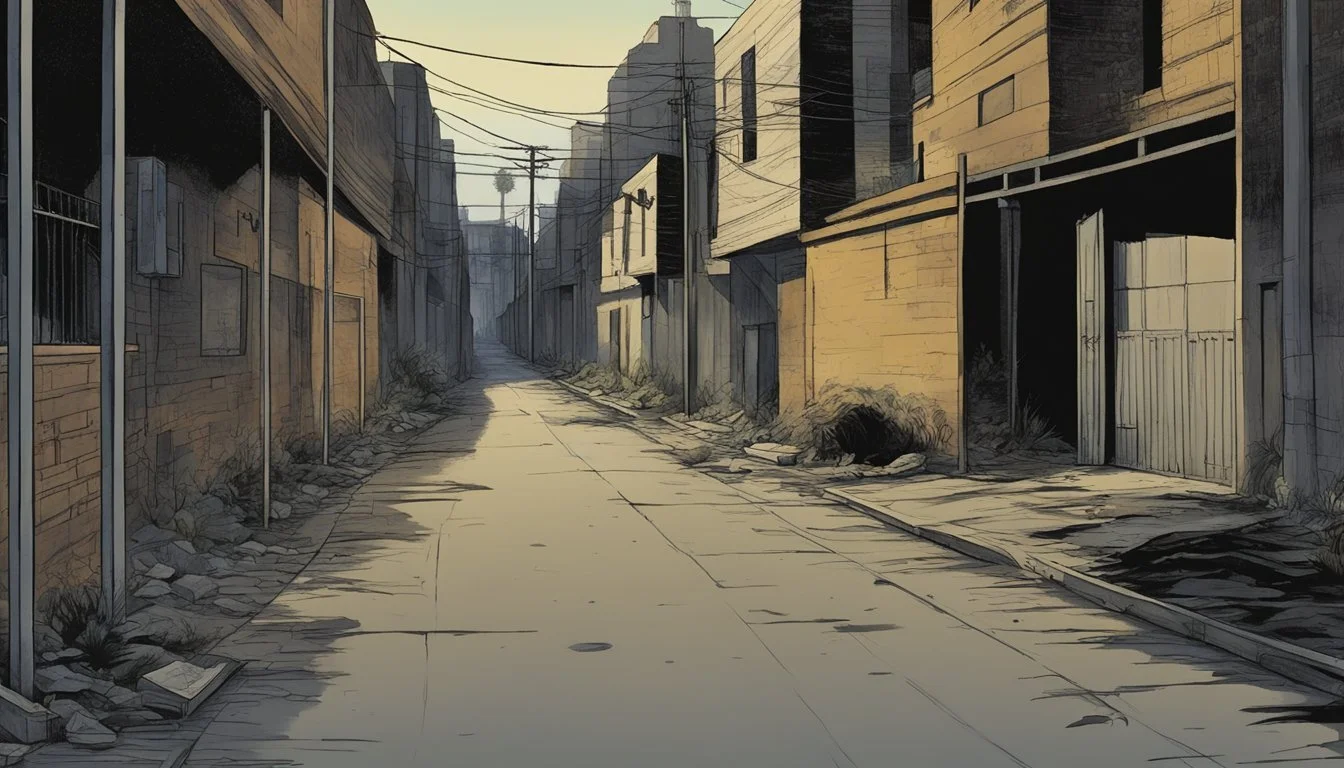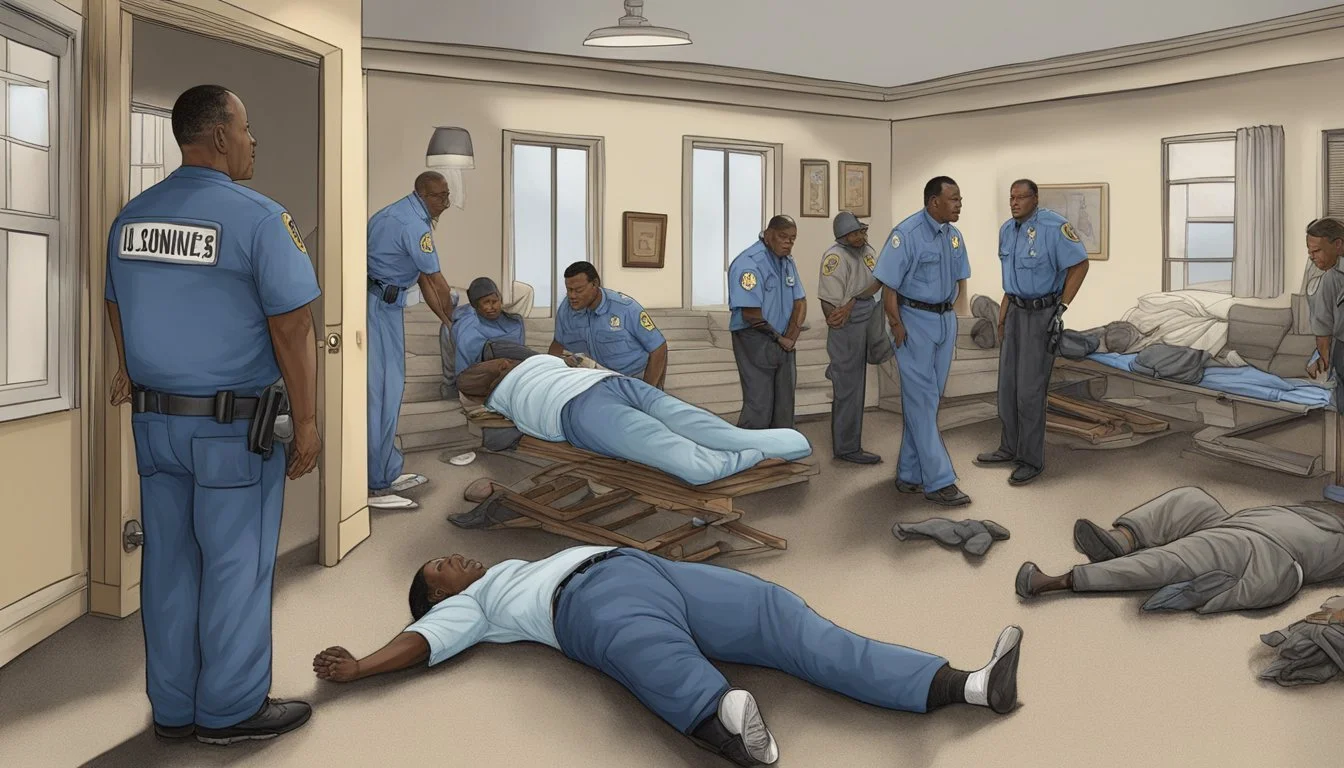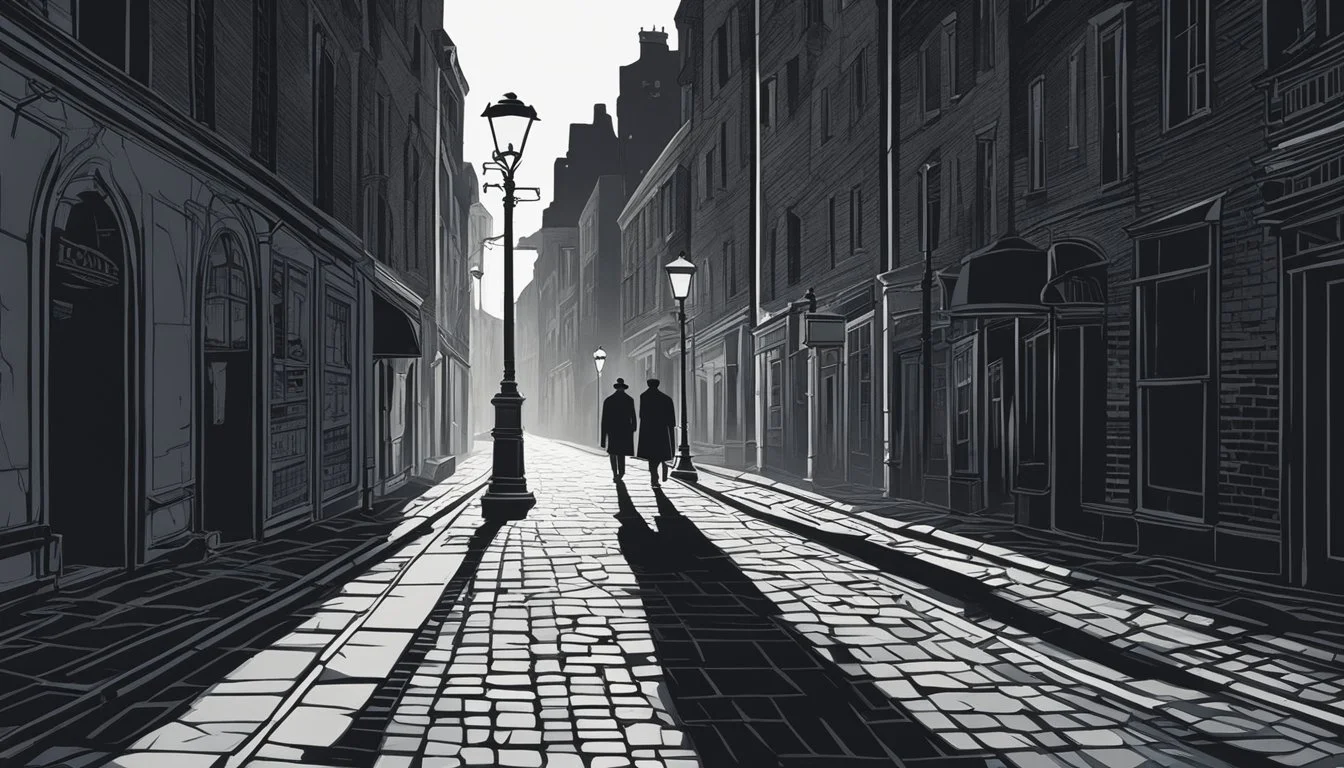Lonnie Franklin Jr.: 9 Decades of Los Angeles History Marked by the Grim Sleeper's Crimes
A Dark Chapter in the City's Past
Lonnie Franklin Jr., infamously known as the Grim Sleeper, left an indelible mark on Los Angeles history through his heinous crimes spanning multiple decades. His case captivated public attention and exposed systemic issues within law enforcement and community relations in South Los Angeles.
The Grim Sleeper's reign of terror stretched from 1984 to 2007, claiming the lives of at least ten women and one girl. Franklin's ability to evade capture for so long highlighted challenges in investigating crimes against marginalized communities and advancements in forensic technology that eventually led to his arrest. The case of the Grim Sleeper serves as a chilling reminder of the impact a serial killer can have on a city and its residents over time.
1) 1985: The First Known Victims
In 1985, Los Angeles witnessed the beginning of a chilling series of murders that would span decades. Lonnie David Franklin Jr., later dubbed the Grim Sleeper, claimed his first known victim that year.
On August 10, 1985, the body of 29-year-old Debra Jackson was discovered in an alley. She had been shot three times in the chest, marking the start of Franklin's deadly spree.
Over the next three years, Franklin continued his brutal attacks. He targeted women in South Los Angeles, leaving a trail of fear and devastation in his wake.
Princess Berthomieux and Valerie McCorvey, both 25 years old, were among the victims during this initial period. Their deaths added to the growing list of unsolved murders in the area.
Franklin's method of operation began to emerge. He typically shot his victims and disposed of their bodies in alleys or dumpsters, evading detection for years to come.
2) 1988: Unsolved Murders Raise Alarms
In 1988, a series of unsolved murders in South Los Angeles sparked growing concern among residents and law enforcement. The victims were predominantly young women, found discarded in alleyways and dumpsters throughout the area.
The Los Angeles Police Department intensified their efforts to investigate these crimes. Despite increased patrols and community outreach, the killer remained elusive. The lack of progress in solving these cases led to mounting frustration and fear within the community.
Local activist groups organized neighborhood watch programs and held vigils for the victims. Media coverage of the murders increased, bringing wider attention to the ongoing threat. The LAPD faced criticism for their handling of the cases, with some accusing them of neglecting crimes in lower-income neighborhoods.
As 1988 drew to a close, the number of unsolved murders continued to grow. The pattern of killings suggested the work of a serial killer, though this was not yet confirmed by police. The lack of closure left families of victims devastated and the community on edge.
3) 2002: DNA Links Found
In 2002, a significant breakthrough occurred in the Grim Sleeper case. DNA technology advancements allowed investigators to link multiple murders to a single perpetrator. This discovery confirmed suspicions that a serial killer had been operating in Los Angeles for decades.
The DNA evidence connected several unsolved homicides dating back to the 1980s. It provided crucial forensic links between crime scenes that had previously seemed unrelated. This development reignited interest in the cold cases and prompted a renewed investigation.
Law enforcement agencies pooled their resources to analyze the DNA findings. They created a task force dedicated to tracking down the elusive killer. The DNA evidence became a central focus of their efforts, as they hoped it would lead them to the perpetrator's identity.
Despite the DNA breakthrough, the Grim Sleeper's true identity remained unknown. The genetic profile did not match any in existing criminal databases. This led investigators to explore new avenues, including familial DNA searches, to find potential leads.
The 2002 DNA links marked a turning point in the investigation. It provided a scientific basis for connecting the crimes and offered hope for eventual resolution. The case gained new momentum, setting the stage for future developments in the hunt for the Grim Sleeper.
4) July 7, 2010: Arrest of Lonnie Franklin Jr.
On July 7, 2010, a significant breakthrough occurred in the long-running Grim Sleeper case. At 9:20 a.m., undercover officers from the Los Angeles Police Department apprehended 57-year-old Lonnie Franklin Jr.
The arrest took place outside Franklin's residence in South Los Angeles. It marked the culmination of an extensive investigation spanning over two decades.
Franklin's capture brought an end to a reign of terror that had gripped the city for years. The serial killer had targeted vulnerable women in the Los Angeles area since the 1980s.
The arrest was met with relief by both law enforcement and the community. Los Angeles Mayor Antonio Villaraigosa declared that the "terror has finally come to an end" following Franklin's capture.
This pivotal moment in the case allowed authorities to move forward with legal proceedings against the suspected Grim Sleeper. It also provided a sense of closure for the victims' families who had long awaited justice.
5) 2016: Trial Begins
In February 2016, the long-awaited trial of Lonnie Franklin Jr. commenced in Los Angeles. Franklin faced charges for 10 murders spanning over two decades, with prosecutors alleging he was the notorious "Grim Sleeper" serial killer.
The trial began with intense media scrutiny and public interest. Prosecutors presented a wealth of evidence, including DNA samples, ballistics reports, and photographs linking Franklin to the crimes.
Key testimony came from survivors and relatives of victims. Their accounts provided chilling details of the attacks and the impact on their lives and communities.
Forensic experts played a crucial role in the proceedings. They explained how advances in DNA technology helped connect Franklin to the murders, even years after they occurred.
The defense argued that the evidence was circumstantial and questioned the reliability of witness statements. They attempted to cast doubt on the prosecution's timeline of events.
As the trial progressed, it shed light on the challenges faced by law enforcement in solving cold cases. It also highlighted issues of racial and economic disparities in crime investigation and reporting.
6) May 5, 2016: Conviction on Multiple Counts
On May 5, 2016, a Los Angeles jury reached a verdict in the Grim Sleeper serial murder trial. The jury found Lonnie Franklin Jr. guilty on 10 counts of first-degree murder.
Franklin was convicted of killing nine women and one teenage girl over a span of three decades in South Los Angeles. The victims were found sprawled in alleys and dumpsters across the city.
The trial marked the culmination of a long investigation that began in the 1980s. Franklin's crimes earned him the nickname "Grim Sleeper" due to an apparent long break between his killings.
The conviction brought a sense of closure to the families of the victims and the community that had lived in fear for years. It also highlighted the persistence of law enforcement in solving cold cases.
Franklin's trial attracted significant media attention, shedding light on the impact of serial killings on urban communities. The case underscored the importance of advances in forensic technology in solving complex criminal cases.
7) August 10, 2016: Sentenced to Death
On August 10, 2016, Lonnie Franklin Jr., known as the "Grim Sleeper," received his final sentence in a Los Angeles courtroom. Superior Court Judge Kathleen Kennedy handed down the death penalty for his crimes.
Franklin was convicted of murdering nine women and a teenage girl over a span of three decades. The sentencing brought a sense of closure to the victims' families who had waited years for justice.
The courtroom was filled with emotion as family members of the victims addressed Franklin directly. Some expressed their anger, while others shared memories of their lost loved ones.
Judge Kennedy described Franklin's crimes as "monstrous" and emphasized the devastating impact on the community. She stated that the death penalty was appropriate given the nature and extent of his actions.
The sentence marked the end of a long legal process that began with Franklin's arrest in 2010. It also represented a significant moment in Los Angeles criminal history, closing a chapter on one of the city's most notorious serial killer cases.
8) 2017: Investigation into Additional Murders
In 2017, investigators reopened cold cases potentially linked to Lonnie Franklin Jr., the Grim Sleeper. They examined unsolved murders from the 1970s and 1980s, looking for connections to Franklin's known crimes.
Detectives reviewed old evidence and photographs found in Franklin's home. They sought DNA matches and compared victim profiles to establish possible links to additional murders.
The Los Angeles Police Department assigned a task force to this investigation. They focused on cases with similar victim characteristics and methods to those used by Franklin.
While no new charges were filed in 2017, the investigation continued. Authorities believed Franklin may have been responsible for more than the ten murders he was convicted of in 2016.
This renewed effort aimed to bring closure to more families and shed light on Los Angeles' troubled history with serial killers. It also highlighted the importance of preserving evidence in cold cases for future technological advancements.
9) 2020: Death in Prison
Lonnie Franklin Jr.'s life came to an end on March 28, 2020, at San Quentin State Prison in California. The notorious serial killer, known as the "Grim Sleeper," was found unresponsive in his cell on death row.
Franklin was 67 years old at the time of his death. Prison officials discovered him during a routine security check and pronounced him dead shortly after. The cause of death was not immediately apparent.
The California Department of Corrections and Rehabilitation reported that there were no signs of trauma. An autopsy was scheduled to determine the exact cause of Franklin's death.
Franklin's passing occurred just four years after his conviction for the murders of ten women in Los Angeles. He had been on death row since 2016, awaiting execution for his crimes.
The death of the Grim Sleeper marked the end of a dark chapter in Los Angeles history. It brought a sense of closure to the families of his victims and the communities affected by his decades-long reign of terror.
Early Life and Background
Lonnie David Franklin Jr. was born on August 30, 1952, in Los Angeles, California. His early years were shaped by the environment of South Central LA and his later military service.
Childhood in South Central
Franklin grew up in South Central Los Angeles during the 1950s and 1960s. This area was known for its diverse working-class population and faced economic challenges. Details about Franklin's family life and education remain limited in public records.
The neighborhood experienced significant demographic shifts during his youth. These changes impacted local communities and institutions.
Franklin's early interactions with law enforcement began in his teenage years. He had several minor run-ins with police, foreshadowing his future criminal activities.
Military Service
In April 1974, at age 21, Franklin enlisted in the U.S. Army. He was stationed in Stuttgart, Germany, serving overseas during the post-Vietnam War era.
His military career was short-lived and marked by misconduct. On April 17, 1974, Franklin participated in the kidnapping of a 17-year-old girl in Germany. This incident led to his discharge from the Army.
Franklin's time in the military did not instill discipline or deter his criminal tendencies. Instead, it provided him with new opportunities for illicit behavior away from his home environment.
Upon returning to Los Angeles, Franklin struggled to reintegrate into civilian life. His criminal activities escalated in the years following his military service.
Criminal Activities
Lonnie Franklin Jr.'s reign of terror spanned over two decades, leaving a trail of victims and evading capture for years. His crimes shocked Los Angeles and earned him the chilling moniker "The Grim Sleeper."
The Grim Sleeper Murders
Franklin targeted young Black women in South Central Los Angeles from 1984 to 2007. He murdered at least 10 victims and attempted to kill another. His method involved shooting or strangling his victims, then dumping their bodies in alleys and dumpsters.
The killer earned the name "Grim Sleeper" due to an apparent 14-year gap in his crimes between 1988 and 2002. However, some speculate he may have continued killing during this period without detection.
Franklin's victims were often vulnerable women, including sex workers and those struggling with addiction. He exploited their circumstances to avoid suspicion and continue his murderous spree.
Capture and Arrest
Franklin's crimes went unsolved for decades until DNA evidence finally led to his capture. On July 7, 2010, undercover LAPD officers arrested the 57-year-old outside his home in South Los Angeles.
The breakthrough came when investigators used familial DNA matching. They found a partial match between crime scene evidence and Franklin's son, who was in a criminal database. This led them to focus on Franklin as a suspect.
A discarded pizza crust provided the final piece of evidence needed to confirm Franklin's identity as the Grim Sleeper. Police recovered the crust after Franklin attended a birthday party, allowing them to obtain his DNA profile.
Impact on Los Angeles
The Grim Sleeper case profoundly affected Los Angeles, shaping community reactions, media coverage, and police procedures. It exposed deep-rooted issues within the city and sparked important conversations about public safety and institutional accountability.
Community Response
The Grim Sleeper's crimes sent shockwaves through South Los Angeles neighborhoods. Residents experienced fear and uncertainty, particularly in areas where victims were found. Community groups organized street patrols and awareness campaigns to protect vulnerable individuals.
Local activists criticized law enforcement for the slow progress in solving the case. They argued that socioeconomic factors and racial biases contributed to the lack of urgency in the investigation.
Vigils and memorials honored the victims, bringing together families and supporters. These events fostered a sense of unity and resilience among community members affected by the crimes.
Media Coverage
The Grim Sleeper case garnered significant media attention, both locally and nationally. Initial reports focused on the mysterious nature of the killings and the lengthy gaps between murders.
As the investigation progressed, media outlets delved into the victims' backgrounds and the challenges faced by law enforcement. Some coverage drew criticism for sensationalizing aspects of the case or perpetuating harmful stereotypes.
Documentaries and true crime series explored the Grim Sleeper's impact on Los Angeles. These productions often highlighted systemic issues within the LAPD and the criminal justice system.
The media played a crucial role in keeping the case in the public eye, potentially contributing to its eventual resolution.
Police Investigations
The Grim Sleeper case exposed shortcomings in LAPD's handling of serial killings. Initially, the department failed to connect the murders, leading to delays in identifying a pattern.
The creation of a dedicated task force in 2007 marked a turning point in the investigation. This team utilized advanced DNA analysis techniques and data mining to narrow down potential suspects.
Community pressure and media scrutiny pushed the LAPD to allocate more resources to solving cold cases in underserved areas. The department implemented new protocols for handling serial crimes and improved communication with affected communities.
The successful resolution of the Grim Sleeper case led to a reevaluation of other unsolved murders in Los Angeles, potentially bringing closure to additional families.











